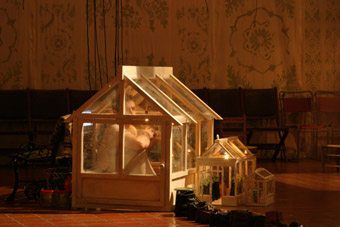Memories and micro-worlds
Sarah Neville

Jason Sweeney, Babushka
photo Peter Heydrich
Jason Sweeney, Babushka
Nostalgic and wistful, Ingrid Voorendt’s Babushka is a mixed media performance featuring the talents of some of Adelaide’s most interesting independent artists. Produced as part of Parallelo’s Open Platform (POP) initiative, this historical reverie was created from the performers’ childhood memories with selective interpretations of family life, dreams, aspirations and regrets. Voorendt fashioned the performance around re-enactments and responses to moments past.
The Russian Babushka doll is employed as a metaphor with small scenes recounting personal history embodied and voiced by Helen Omand, Naida Chinner, Solon Ulbrich, Astrid Pill, Jason Sweeney and Zoe Barry. The performers reminisce as they dress up in their parents’ and grandparents’ clothes and step into their shoes. We see a combination of tableaux gleaned from photographs and movement choreographed through gestural references, all bound by a motif of running that slows, halts, repeats, races and drags like childhood memory.
The 6 performers create parallel journeys inside a child’s playroom. Designer Justine Shih Pearson’s scaled-down glasshouse could also be a transparent doll’s house modelled on the venue for the performance, the auditorium at the Art Gallery of South Australia. The children’s toys, which are at the same time creative tools for the performers, are arranged prettily and metaphorically to illustrate their personal recollections. There’s a giant dress, piles of toys, tea sets, some electronic equipment and old shoes. This installation of micro-worlds implicitly invites the audience to respond with their own childhood memories.
The distinction between the real world of children and Voorendt’s theatrical excursion is that children generally act out imagined futures whereas the players, dressed in mostly 1940s style, act out family memories in the guise of children and portray childish actions. An exception is the moment when Helen Omand dons some trainers and sprints around the room expressing concerns about her age, marital status and past achievements. Naida Chinner’s solemn drinking circle in which she skols shots of white liquor in quick succession is also distinctly adult. Here the performers might be reflecting on their present lives or on the actions of parents or grandparents. The origin of the actions appears to be purposely ambiguous.
Aside from a shared European heritage, each performer’s journey appears unrelated to the others. The standout performance is from Astrid Pill who uses her beautiful, classically-trained voice to express sentimental emotions derived from Naida Chinner’s memories of her grandmother. The Latvian lullabies she sings are poignant and haunting. Pill’s performance is captivating and slightly spooky, her grounded physicality working against any overly nostalgic interpretation. Her wonderful rendition of David Bowie’s Let’s Dance, accompanied by Zoe Barry on piano accordion, is a highlight. Likewise Helen Omand’s comic ability comes to the fore as she energetically demands attention from everyone in the room with a noisy pair of kid’s slippers and then attempts to integrate herself into family portraits via some tempestuous posturing. Solon Ulbrich’s eloquent movement and muttering vocals perfectly illustrate a stoic domesticity. Later he dances cheek to cheek with Naida Chinner who, throughout the piece, appears curiously lost in her own world while simultaneously in constant flight.
Jason Sweeney’s soundscape is appropriately subtle, punctuated at one time by the voice of Omand’s grandmother telling an animated story about a goanna and at another by the melody of Puff the Magic Dragon that locates the work in an imaginary, childlike realm. Both Sweeney and Pill speak the unfulfilled wish lists of their ancestors into electric light bulbs (which are also microphones). The dialogue extends into the audience when Chinner and Pill play an intimate Chinese Whispers game followed by a call and response scene (“Put your hand up if…”) warmly inviting us into the children’s world.
The audience is given lit candles to hold and extinguish at will to signal the end of the show. The piece could easily have been repeated or continued in a durational fashion as it employs no apparent dramatic score.
Babushka displays moments of wistful montage recalled and re-enacted with considerable skill but without analysis or attitude. I was left trying to open the next Babushka doll, wondering how each family history had affected the outlook of individual or community and how the experience of one generation might have influenced the next.
Parallelo Open Platform (POP), Babushka, Auditorium, Art Gallery of South Australia, North Terrace, Adelaide, May 25-29
RealTime issue #62 Aug-Sept 2004 pg. 10






